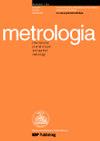使用学生 t 分布的稳健空间应用时间尺度
IF 2.4
3区 工程技术
Q2 INSTRUMENTS & INSTRUMENTATION
引用次数: 0
摘要
本文将稳健估计原理应用于标准基本时标方程,从而获得一种为时钟分配权重的新方法。具体来说,本文引入了学生 t 分布作为一种新的统计模型,用于测量链路中出现相位跳变、频率跳变或异常的时钟群。提议的稳健时间尺度旨在减轻这些异常的影响,但不一定要识别它们,而是通过应用一种稳健估计学生 t 分布参数的方法。使用学生 t 分布(ATST)的拟议时间尺度算法在相位跳跃、频率跳跃和测量异常方面的鲁棒性与 AT1 甲骨文时间尺度相当。AT1 甲骨文是 AT1 时间尺度的一种特殊实现,它通过事先了解异常情况的发生来纠正所有异常情况。ATST 和 AT1 oracle 相似的性能表明,ATST 算法可以在不预先知道或检测异常发生的情况下有效地获得稳健性。本文章由计算机程序翻译,如有差异,请以英文原文为准。
A robust time scale for space applications using the student’s t-distribution
In this article, the principles of robust estimation are applied to the standard basic time scale equation to obtain a new method of assigning weights to clocks. Specifically, the Student’s t-distribution is introduced as a new statistical model for an ensemble of clocks that are experiencing phase jumps, frequency jumps or anomalies in their measurement links. The proposed robust time scale is designed to mitigate the effects of these anomalies without necessarily identifying them, but through applying a method of robust estimation for the parameters of a Student’s t-distribution. The proposed time scale algorithm using the Student’s t-distribution (ATST) is shown to achieve comparable robustness to phase jumps, frequency jumps, and anomalies in the measurements with respect to the AT1 oracle time scale. The AT1 oracle is a special realization of the AT1 time scale which corrects all anomalies by having prior knowledge of their occurrences. The similar performance of ATST and AT1 oracle suggests that the ATST algorithm is efficient for obtaining robustness with no prior knowledge or detection of the occurrences of anomalies.
求助全文
通过发布文献求助,成功后即可免费获取论文全文。
去求助
来源期刊

Metrologia
工程技术-物理:应用
CiteScore
2.80
自引率
25.00%
发文量
137
审稿时长
12 months
期刊介绍:
Published 6 times per year, Metrologia covers the fundamentals of measurements, particularly those dealing with the seven base units of the International System of Units (metre, kilogram, second, ampere, kelvin, candela, mole) or proposals to replace them.
The journal also publishes papers that contribute to the solution of difficult measurement problems and improve the accuracy of derived units and constants that are of fundamental importance to physics.
In addition to regular papers, the journal publishes review articles, issues devoted to single topics of timely interest and occasional conference proceedings. Letters to the Editor and Short Communications (generally three pages or less) are also considered.
 求助内容:
求助内容: 应助结果提醒方式:
应助结果提醒方式:


